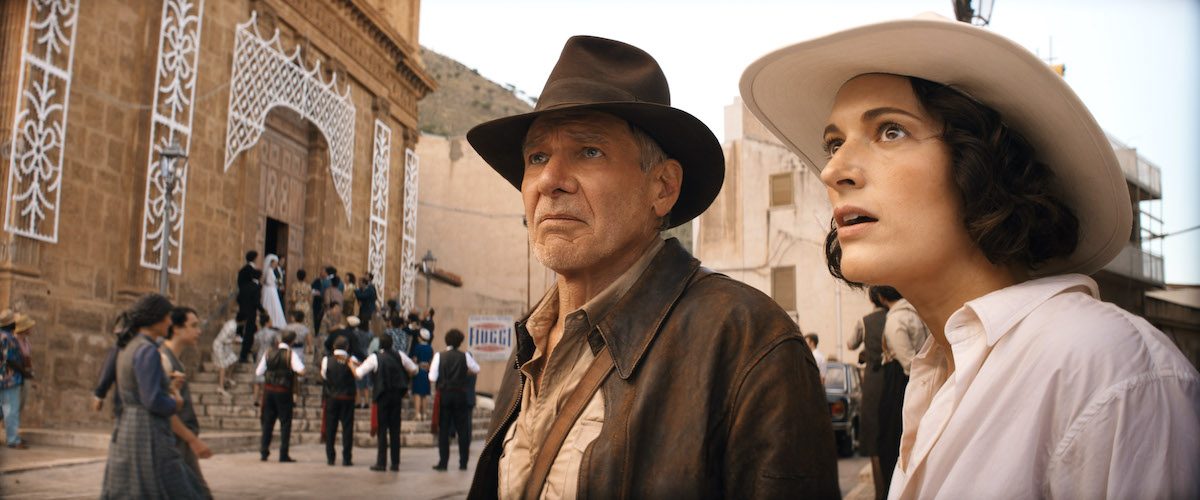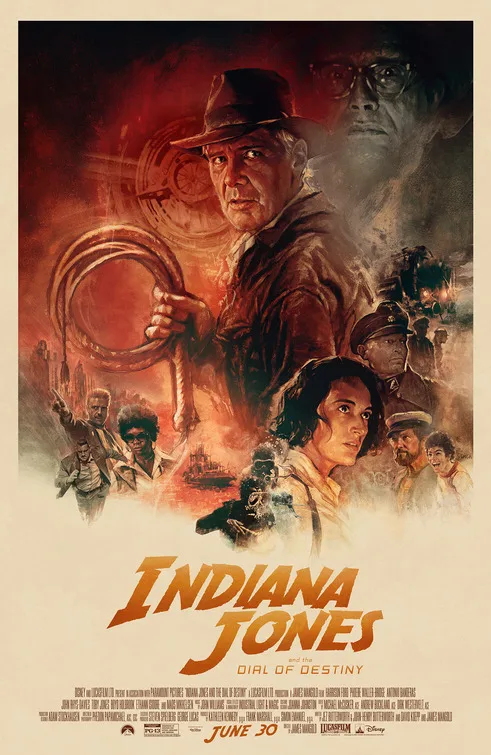“Indiana Jones and the Dial of Destiny” is somehow both never boring and never really entertaining. It walks a line of modest interest in what’s going to happen next thanks to equal parts innovative story beats and the foundation of nostalgia that everyone brings to the theater. It’s an alternating series of frustrating choices, promising beats, and general goodwill for a legendary actor donning one of the most famous hats in movie history yet again. It should be better. It could have been worse. Both can be true. In an era of extreme online critical opinion, “The Dial of Destiny” is a hard movie to truly hate, which is nice. It’s also an Indiana Jones movie that’s difficult to truly love, which makes this massive fan of the original trilogy a little sad.
The unsettling mix of good and bad starts in the first sequence, a flashback to the final days of World War II that features Indy (Harrison Ford) and a colleague named Basil Shaw (Toby Jones) trying to reclaim some of the historical artifacts being stolen by the fleeing Nazis. Jones looks normal, of course, but Ford here is an uncanny valley occupant, a figure of de-aged CGI that never looks quite human. He doesn’t move or even sound quite right. It’s the first but not the last time in “The Dial of Destiny” in which it feels like you can’t really get your hands on what you’re watching. It sets up a standard of over-used effects that are the film’s greatest flaw. We’re watching Indiana Jones at the end of World War II, but the effects are distracting instead of enhancing.
It’s a shame, too, because the structure of the prologue is solid. Indy escapes capture from a Nazi played by Thomas Kretschmann, but the important introduction here is that of a Nazi astrophysicist named Jurgen Voller (a de-aged Mads Mikkelsen), who discovers that, while looking for something called the Lance of Longinus, the Nazis have stumbled upon half of the Antikythera, or Archimedes’ Dial. Based on a real Ancient Greek item that could reportedly predict astronomical positions for decades, the dial is given the magical Indy franchise treatment in ways that I won’t spoil other than to say it’s not as explicitly religious as items like the Ark of the Covenant of The Holy Grail other than, as Voller says, it almost makes its owner God.
After a cleverly staged sequence involving anti-aircraft fire and dozens of dead Nazis, “The Dial of Destiny” jumps to 1969. An elderly Indiana Jones is retiring from Hunter College, unsure of what comes next in part because he’s separated from Marion after the death of their son Mutt in the Vietnam War. The best thing about “The Dial of Destiny” starts here in the emotional undercurrents in Harrison Ford’s performance. He could have lazily walked through playing Indy again, but he very clearly asked where this man would be emotionally at this point in his life. Ford’s dramatic choices, especially in the film’s back half, can be remarkable, reminding one how good he can be with the right material. His work here made me truly hope that he gets a brilliant drama again in his career, the kind he made more often in the ‘80s.
But back to the action/adventure stuff. Before he can put his retirement gift away, Indy is whisked off on an adventure with Helena Shaw (Phoebe Waller-Bridge), the daughter of Basil and goddaughter of Indy. It turns out that Basil became obsessed with the dial after their encounter with it a quarter-century ago, and Indy told him he would destroy the half of the dial they found. Of course, Indiana Jones doesn’t destroy historical artifacts. As they’re getting the dial from the storeroom, they’re attacked by Voller and his goons, leading to a horse chase through the subway during a parade. It’s a cluttered, awkward action sequence with power that’s purely nostalgic—an iconic hero riding a horse through a parade being thrown for someone else.
Before you know it, everyone is in Tangier, where Helena wants to sell her half of the dial, and the film injects its final major character into the action with a sidekick named Teddy (Ethann Isidore). From here, “The Dial of Destiny” becomes a traditional Indy chase movie with Jones and his team trying to stay ahead of the bad guys while leading them to what they’re trying to uncover.
James Mangold has delivered on “old-man hero action” before with the excellent “Logan,” but he gets lost on the journey here, unable to stage action sequences in a way that’s anywhere near as engaging as how Steven Spielberg does the same. Yes, we’re in a different era. CGI is more prevalent. But that doesn’t excuse clunky, awkward, incoherent action choreography. Look at films like “John Wick: Chapter 4” or a little sequel that’s coming out in a few weeks that I’m not really supposed to talk about—even with the CGI enhancements, you know where the characters are at almost all times, what they’re trying to accomplish, and what stands in their way.
That basic action structure often falls apart in “The Dial of Destiny.” There’s a car chase scene through Tangier that’s incredibly frustrating, a blur of activity that should work on paper but has no weight and no real stakes. A later scene in a shipwreck that should be claustrophobic is similarly clunky in terms of basic composition. I know not everyone can be Spielberg, but the simple framing of action sequences in “Raiders of the Lost Ark” and even “Indiana Jones and the Last Crusade” is gone here, replaced by sequences that cost so much that they somehow elevated the budget to $300 million. I wished early and often to see this movie’s $100 million version.
“The Dial of Destiny” works much better when it’s less worried about spending that massive budget. When Indy and Helena get to actual treasure-hunting, and John Williams’ all-timer theme kicks in again, the movie clicks. And, without spoiling, it ends with a series of events and ideas that I wish had been foregrounded more in the 130 minutes that preceded it. Ultimately, “The Dial of Destiny” is about a man who wants to control history being thwarted by a man who wants to appreciate it but has arguably allowed himself to get stuck in it through regret or inaction. There’s a powerful emotional center here, but it comes too late to have the impact it could have with a stronger script. One senses that this script was sanded down so many times by producers and rewrites that it lost some of the rough edges it needed to work.
Spielberg reportedly gave Mangold some advice when he passed the whip to the director, telling him, “It’s a movie that’s a trailer from beginning to end—always be moving.” Sure. Trailers are rarely boring. But they’re never as entertaining as a great movie.
In theaters now.




















